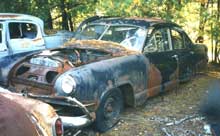It has become the conventional wisdom that Henry J. Kaiser, despite his success with concrete, shipbuilding and healthcare, was a failed automaker. Even with the help of industry veteran Joseph Frazer, formerly with Willys and Graham-Paige, Kaiser was unable to sustain what author Richard Langworth has called the “last onslaught on Detroit.”
The onslaught, if you care to call it that, began with a flourish, new, cleanly-styled cars called, appropriately, Kaiser and Frazer for the 1947 model year. Sales were satisfying in that car-starved postwar market. When marketing got a bit tougher, both Kaiser and Frazer received more interesting grilles and there came a trio of body styles unique to Kaiser-Frazer Corporation. The Traveler and similar Vagabond made up for Kaiser’s lack of a station wagon. A hatch opening at the rear (America’s first hatchback?) and a folding rear seat meant that what was otherwise a Kaiser sedan could carry as much as a station wagon, even, if you were clever, a pony. Kaiser didn’t have a two-door, so they used their four-door as a basis for a convertible, which, with a fixed roof, became a four-door hardtop.
In 1951, the Kaiser was restyled by Howard “Dutch” Darrin, who had penned the first cars. Joe Frazer had left the company and his higher-priced namesake car was due to be phased out, so a few left-over 1950s were given new outer sheet metal and sold as 1951 Frazers. New at Kaiser was a two-door sedan, which had a matching Traveler version.
Making a stab at the compact car market that had been successful for Nash, Kaiser brought out his own small car, the Henry J. The Henry J, however, was a fairly austere car with only one body style, no match for the fully-quipped Nash Rambler that came as a convertible or station wagon. To fill the void left by the demise of Frazer, Kaiser tried some new twists, like the gussied-up Virginian in 1952 and bamboo-like interiors in ’53. A Dragon model featured some even more opulent innards.
A new grille in 1954, and a plastic-bodied Kaiser Darrin sports car were last-ditch efforts. Kaiser couldn’t afford a V8 engine, so they offered a McCulloch supercharger on their ex-Graham, Continental-designed L-head six. None of it helped, and Kaiser sold the tooling to South America in 1955 and ceased to build cars in the U.S.
But that wasn’t the end of Henry J. Kaiser, the automaker. In 1953, in a much-leveraged buyout, he had bought Willys-Overland Motors of Toledo, Ohio. Willys had supplied engines for the Henry J, and did so for the Kaiser Darrin as well. Willys’ “Aero” passenger cars, while better appointed than the Henry J, were not doing well in the market, but the perennial Jeeps were often profitable. At the end of carmaking, Kaiser continued to build the Jeep line and, changing the corporate name to Kaiser Jeep, introduced the Jeep Wagoneer in 1963, arguably the first American upscale sport utility. The Jeepster Commando filled another niche, and the CJ series of Jeeps maintained their hard-core constituency.
Henry J. Kaiser may thus be called the godfather of the sport utility vehicle, ushering Jeep through an uncertain adolescence until its discovery by Roy Chapin, Jr. of American Motors Corporation. By this time, all American automakers were pumping out SUVs, the success of which led to Chrysler’s purchase of AMC in 1987 in order to get the Jeep name and product line. Failed automaker indeed!

